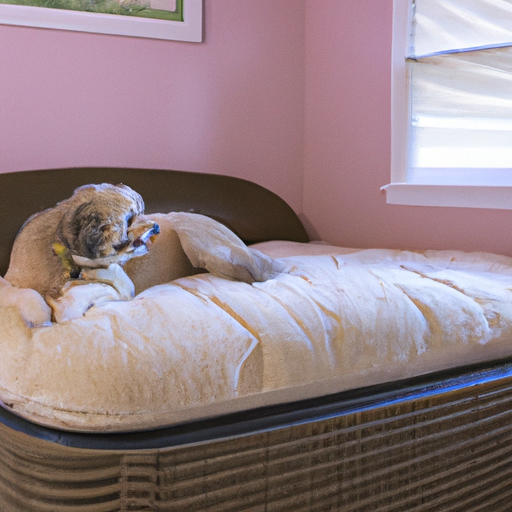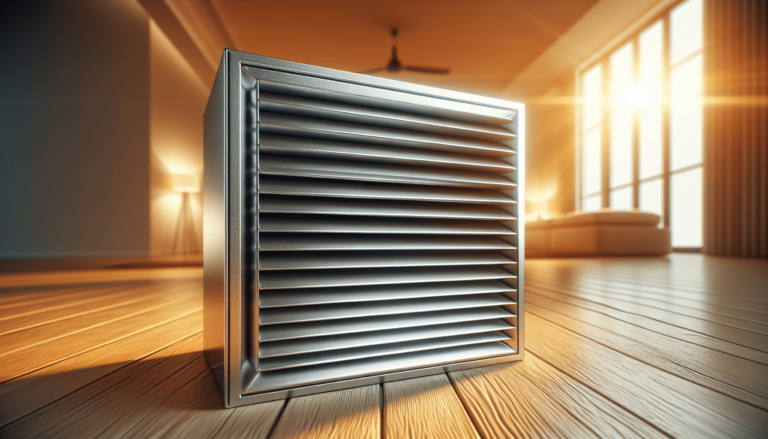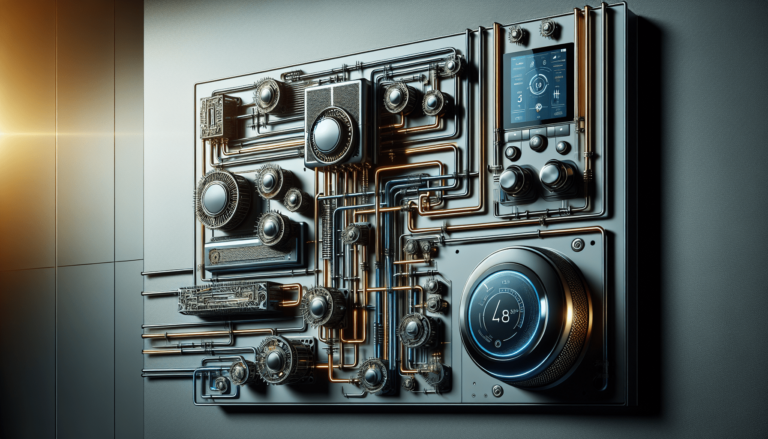

HVAC Services
Get Professional Repairs From The Area's Trusted HVAC Technicians. Ask About Our Services! We Offer Professional Heating & Cooling System Repairs And Guarantee Long-Lasting Results.
Got Question? Call us: (850) 678-2665Financing
Optimizing Your HVAC For Pet Owners
Optimize your HVAC system for pet-friendly living. Discover valuable tips and insights on creating a harmonious indoor environment for you and your furry friend.

Are you a proud pet owner who wants to ensure the comfort and well-being of your furry friend? Look no further than optimizing your HVAC system! This article will provide you with valuable tips and insights on how to create a pet-friendly indoor environment while maximizing the efficiency of your heating and air conditioning. From controlling pet hair and dander to maintaining optimal temperature and air quality, we’ve got you covered. So, grab a cozy spot with your beloved pet and get ready to discover the secrets to a harmonious living space that caters to both you and your four-legged companion.
Choosing the right HVAC system
1.1 Size considerations
When it comes to choosing the right HVAC system for pet owners, size considerations are crucial. You need to ensure that the system you select is suitable for the size of your home and the number of pets you have. A system that is too small may struggle to maintain a comfortable temperature, while a system that is too large can waste energy and result in higher utility bills. Consulting with a professional HVAC contractor can help you determine the appropriate size for your specific needs.
1.2 Filter type
Another important factor to consider is the type of filter used in your HVAC system. Pets can contribute to increased levels of airborne particles, including pet hair and dander. Therefore, it is essential to choose a filter that is capable of capturing these particles effectively. HEPA (High-Efficiency Particulate Air) filters are highly recommended for pet owners, as they are designed to trap even the smallest particles, ensuring cleaner air for you and your pets.
1.3 Noise level
While noise may not be the first thing that comes to mind when thinking about HVAC systems for pet owners, it is nonetheless an important consideration. Loud HVAC units or constant running noises can be stressful for your pets, causing anxiety or restlessness. Selecting a system that operates quietly can help create a more peaceful environment for both you and your furry friends. When comparing different HVAC units, pay attention to their noise level ratings and choose one that is designed to operate quietly.
Maintaining clean air
2.1 Importance of clean air for pets
Clean air is not only important for your own health but is also crucial for the well-being of your pets. Pets, especially those with respiratory issues or allergies, are particularly susceptible to the effects of poor air quality. Maintaining clean air in your home can help prevent or alleviate respiratory problems and reduce the risk of allergies in your furry companions. Investing in an HVAC system that promotes clean air is a significant step towards ensuring the health and comfort of your pets.
2.2 Regular air filter replacement
One of the simplest and most effective ways to maintain clean air in your home is by regularly replacing the air filters in your HVAC system. Over time, filters can become clogged with pet hair, dander, and other airborne particles, compromising their efficiency. By replacing these filters according to the manufacturer’s recommendations, you can ensure optimal airflow and filtration, reducing the amount of pet-related pollutants in your home.
2.3 Air purifiers for pet owners
In addition to regular air filter replacement, pet owners may also consider using air purifiers to further improve the indoor air quality. Air purifiers equipped with HEPA filters can efficiently capture pet hair, dander, and other allergens, helping to reduce their presence in the air. Placing air purifiers strategically throughout your home can help provide clean and fresh air for both you and your pets.
Controlling pet hair and dander
3.1 Regular grooming
Regular grooming is key to controlling pet hair and dander in your home. By brushing your pets’ fur frequently, you can remove loose hair and prevent it from accumulating on your furniture, floors, and HVAC system. Additionally, grooming helps to reduce the amount of dander shed by your pets, minimizing potential allergens in the air. Make sure to use appropriate grooming tools and techniques to keep your pets’ coat clean and healthy.
3.2 Vacuuming and cleaning
Proper cleaning practices play a crucial role in managing pet hair and dander. Regular vacuuming, using a high-quality vacuum cleaner equipped with pet-specific attachments, can help remove hair and dander from carpets, rugs, and upholstery. It is also important to regularly mop hard surfaces to minimize the buildup of pet-related pollutants. By maintaining a clean living environment, you can significantly reduce the circulation of pet hair and dander through your HVAC system.
3.3 Using air filters for pet hair
In addition to grooming and cleaning, using air filters specifically designed to capture pet hair can help control its presence in your home. These specialized filters are typically electrostatically charged to attract and trap hair and other particles. By installing these filters in your HVAC system, you can minimize the accumulation of pet hair in your ductwork and improve overall air quality.
Managing pet odors
4.1 Proper ventilation
Pet odors can be a challenge for many pet owners. Proper ventilation is essential to circulate fresh air and eliminate unpleasant smells. Opening windows or using exhaust fans in areas where your pets spend a lot of time can help remove odors and improve air quality. Additionally, consider installing ventilation systems, such as whole-house fans or air exchangers, to continuously bring in fresh air while exhausting stale air.
4.2 Air fresheners and deodorizers
While air fresheners and deodorizers may provide temporary relief from pet odors, it is important to use them sparingly and choose pet-friendly options. Some commercial products contain chemicals that can be harmful to pets if ingested or inhaled. Instead, opt for natural alternatives, such as baking soda or activated charcoal, to absorb and neutralize odors. Regularly washing and cleaning pet bedding and furniture can also help eliminate lingering smells.
4.3 Cleaning pet bedding and furniture
Another effective way to manage pet odors is by regularly cleaning your pets’ bedding and the furniture they frequently use. These areas can quickly accumulate pet hair, dander, and odors, contributing to the overall smell in your home. Follow manufacturer’s instructions for washing pet bedding to ensure thorough cleaning without damaging the materials. Consider using odor-neutralizing detergents to eliminate any residual smells.
Protecting HVAC equipment
5.1 Pet-proofing the HVAC system
Pets are naturally curious and can potentially cause damage to your HVAC system if precautions are not taken. To protect your equipment, pet-proofing measures should be implemented. Close off access to HVAC units and vents so that pets cannot get inside or cause any harm. Additionally, consider using protective covers or barriers to prevent pets from scratching or chewing on exposed components. By taking these preventative steps, you can avoid costly repairs and potential safety hazards.
5.2 Regular maintenance and inspections
Regular maintenance and inspections are essential for keeping your HVAC system in optimal condition, especially in households with pets. Pets can shed hair that can accumulate within the system, affecting its efficiency and airflow. Regularly scheduled HVAC maintenance, including cleaning of the system components, can help prevent buildup and ensure proper functionality. Professional technicians can also inspect for any pet-related damage and address any issues promptly.
5.3 Professional duct cleaning
Over time, pet hair, dander, and other particles can accumulate in your ductwork, reducing airflow and contributing to poor indoor air quality. Professional duct cleaning is highly recommended for pet owners to remove these accumulated contaminants. By having your ducts professionally cleaned, you can improve overall air quality, reduce pet-related allergens, and prevent potential respiratory issues for both you and your pets.
Regulating temperature for pets
6.1 Optimal temperature range for pets
Pets have specific temperature preferences, and it is important to consider their comfort when setting the thermostat. In general, the optimal temperature range for most pets is between 68°F and 78°F (20°C to 25°C). However, factors such as breed, size, and coat thickness can influence their ideal temperature. Monitoring your pets’ behavior and adjusting the temperature accordingly can help ensure their well-being and comfort.
6.2 Using programmable thermostats
Programmable thermostats are a valuable tool for pet owners, allowing you to automatically adjust the temperature based on your pets’ needs. You can program different temperature settings for various times of the day to provide comfort while minimizing energy consumption when no one is home. This allows you to maintain a suitable environment for your pets without having to manually adjust the thermostat constantly.
6.3 Zoning systems for different areas
If you have pets that occupy different areas of your home, consider implementing a zoning system for your HVAC. Zoning systems allow you to regulate the temperature independently in different zones or rooms, ensuring that each area accommodates your pets’ specific needs. This way, you can provide a comfortable environment for your pets without affecting the rest of the house, optimizing their comfort and energy efficiency.
Considering noise sensitivity
7.1 Minimizing loud noises
Pets can be sensitive to loud noises, causing stress and anxiety. Minimizing loud noises, such as those produced by HVAC units, can help create a more peaceful environment for your pets. When selecting an HVAC system, consider its noise level rating and choose one that operates quietly. Regular maintenance and inspections can also help identify and address any noise-related issues in your HVAC system.
7.2 Soundproofing options
If your pets are particularly sensitive to noise, consider implementing soundproofing measures in your home. Adding insulation to walls, floors, and ceilings can help reduce the transmission of noise from your HVAC system and other sources. Soundproof curtains or acoustic panels can also be installed to absorb and dampen sounds. By soundproofing your home, you can create a more serene atmosphere for your pets.
7.3 Choosing quieter HVAC units
When it comes to minimizing noise from your HVAC system, selecting a quieter unit is crucial. Many manufacturers offer HVAC units specifically designed to operate quietly, reducing the noise that can disturb your pets. Before making a purchase, research the noise levels of different units and choose one that meets your pets’ requirements for a calm and tranquil living environment.
Addressing allergies and respiratory issues
8.1 Identifying and managing pet allergies
Allergies to pets can be a challenge for both humans and animals. If you or any members of your household have allergies, it is important to identify and manage them effectively. Consult with a healthcare professional to determine if allergies are the cause of any symptoms and explore treatment options. Implementing the aforementioned measures, such as regular grooming, cleaning, and air filtration, can help reduce allergens and minimize allergic reactions.
8.2 Air purifiers for allergens
Air purifiers equipped with HEPA filters are highly effective in removing allergens, including pet dander, from the air. By continuously filtering and circulating the air, these purifiers can significantly reduce allergen levels, providing relief for allergy sufferers in your home. Place the purifiers in areas frequented by both you and your pets for optimal results.
8.3 HVAC system maintenance for clean air
Regular HVAC system maintenance is crucial for maintaining clean air and minimizing allergens. In addition to changing air filters, professional technicians can clean and inspect the system, ensuring that it operates at its peak efficiency. This maintenance helps to remove any accumulated pet hair or dander from the system, reducing the presence of allergens in the air. By investing in regular maintenance, you can create a healthier environment for both you and your pets.
Ensuring proper ventilation
9.1 Importance of fresh air circulation
Proper ventilation is key to maintaining a healthy and comfortable living environment for both you and your pets. Fresh air circulation helps remove stale air, odors, and potentially harmful air pollutants. Additionally, ventilation can help regulate humidity levels, preventing moisture buildup that can contribute to mold growth. Ensuring proper ventilation is particularly important in homes with pets, as they can release additional pollutants into the air.
9.2 Installing ventilation systems
To enhance the ventilation of your home, consider installing ventilation systems such as whole-house fans or air exchangers. These systems work by continuously pulling in fresh air from outside while exhausting stale air, improving indoor air quality and maintaining a comfortable environment. Consult with an HVAC professional to determine the most suitable ventilation system for your home and pets.
9.3 Opening windows and doors for pets
In addition to mechanical ventilation systems, opening windows and doors can also provide fresh air circulation for your pets. Allowing them access to the outdoors or creating pet-friendly areas with secure screens or enclosures can offer them the opportunity to enjoy the benefits of outdoor air. Just be sure to supervise them and ensure their safety when they are outside.
Hiring professional HVAC services
10.1 Find a pet-friendly HVAC contractor
When hiring HVAC services, it is important to find a contractor that understands the unique needs of pet owners. A pet-friendly contractor will be knowledgeable about the specific challenges and considerations associated with pets and HVAC systems. They will take the necessary steps to protect your pets, such as ensuring secure areas and minimizing disturbance during maintenance or installation.
10.2 Regular maintenance and servicing
Regular maintenance and servicing of your HVAC system are essential for its longevity and efficiency. By scheduling routine maintenance appointments with a professional HVAC technician, you can catch any potential issues early on and ensure that your system is running optimally. Regular servicing also helps maintain clean air quality, particularly in homes with pets, by removing accumulated pet hair, dander, and other allergens from the system.
10.3 Emergency HVAC services
In the event of an HVAC system breakdown or malfunction, prompt repair is crucial, especially for pet owners who rely on their HVAC system to provide a comfortable environment for their pets. When hiring HVAC services, ensure that they offer emergency repair services to address issues quickly and efficiently. This can help minimize any discomfort for your pets and prevent any further damage to your HVAC system.







